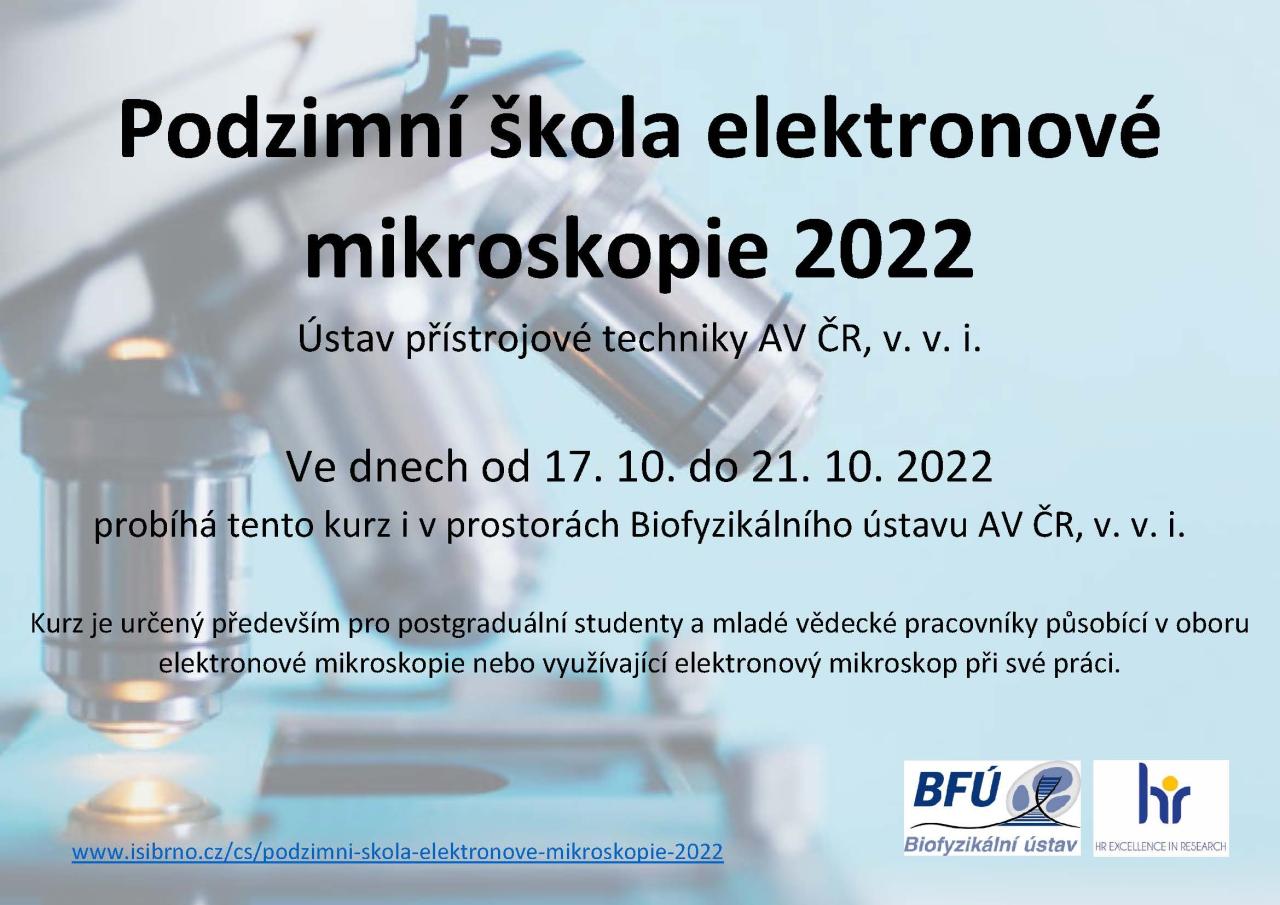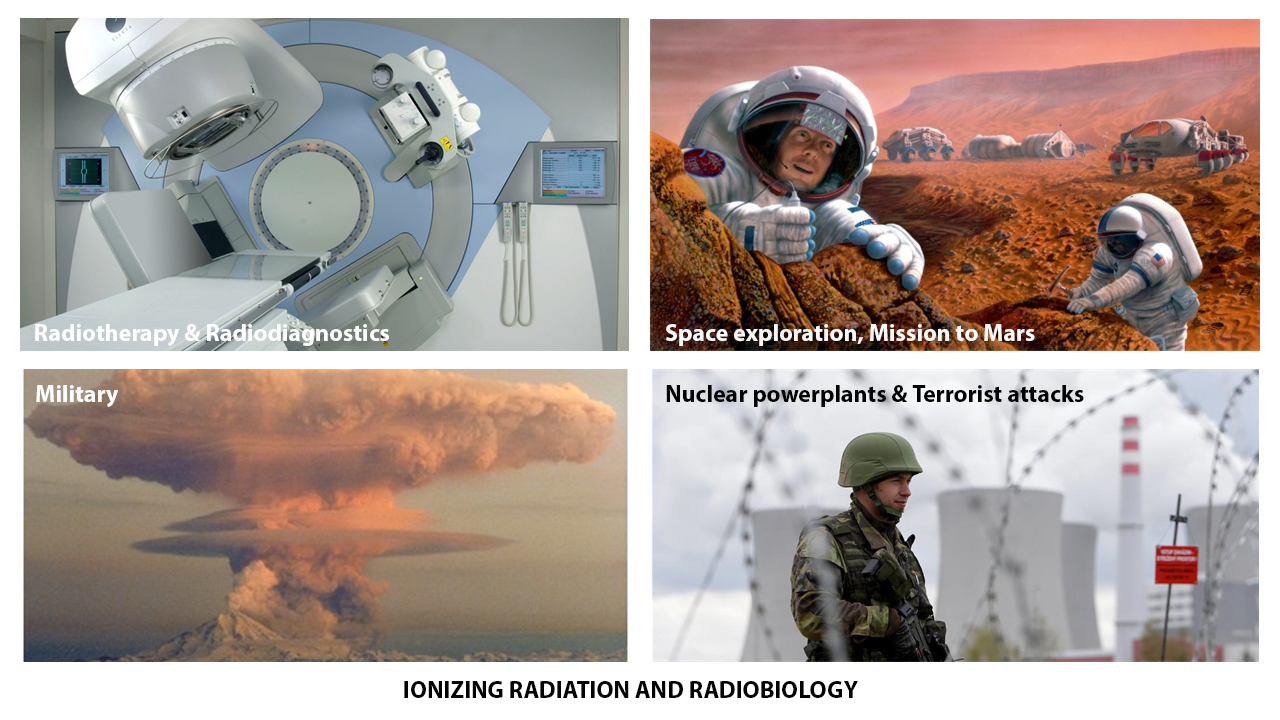News archive
Autumn School of Electron Microscopy 2022
21. 10. 2022

www.isibrno.cz/cs/podzimni-skola-elektronove-mikroskopie-2022
IBP career day: Per Aspera Ad Astra
30. 9. 2022

Young researchers of the Institute of Biophysics (IBP) of the Czech Academy of Sciences are inviting students and postdocs to IBP career day: Per Aspera Ad Astra focused on future career possibilities in the academic and industrial spheres. During the event, four outstanding scientists will share stories of their scientific journeys and will lead popular round table discussions on various topics.
Date & Location: 11.11.2022, Lecture Hall at the Institute of Biophysics
Confirmed speakers:
Vladimíra Petráková is a group leader at Heyrovsky Institute of Physical Chemistry, CAS, where she studies sub-diffraction manipulation of light using plasmonic nanoparticles. After her studies at Czech Technical University in biomedical engineering, she moved to Free University Berlin, where she worked in the Institute of Experimental Physics and Institute of Chemistry and Biochemistry as a Humboldt Fellow. She co-founded Czexpats in Science and is a mother of four children.
Martin Víta is an assistant professor at the Department of mathematics, Prague University of Economics and Business, and a research assistant at the Institute of Physics, CAS. During his Ph.D. studies in Computer systems and technologies at Masaryk University, he undertook an internship at FEP/INESC Porto. He worked as an R&D analyst at the Technology Agency of the Czech Republic. In 2016, he founded ResearchJobs.cz – the first job portal focused on academic and research positions in the Czech Republic.
Panagiotis Alexiou is a research group leader and head of the Bioinformatics Core Facility at the Central European Institute of Technology of Masaryk University. Before joining CEITEC MU, Panagiotis worked as a Research Associate at the University of Pennsylvania in the United States. He has authored several scientific manuscripts and secured national and international funding including the prestigious EMBO Installation Grant.
Vratislav Košťál is a chief product officer (R&D) in TESCAN, a Brno-based, global producer of electron microscopes. Vratislav studied analytical chemistry at the Brno University of Technology, then he developed instruments at the Academy of Sciences of the Czech Republic. He worked for five years at the University of Minnesota, USA, where he first encountered an electron microscope. After returning to Brno, he joined TESCAN as an application engineer.
Program:
12:30-13:00 registration
13:00-13:10 introduction by Hana Polasek-Sedlackova on behalf of the organization team
13:10-13:40 Using Professional and Personal Networks for Career Decisions and Progress by Vladimíra Petráková
group leader at J. Heyrovsky Institute of Physical Chemistry, Czech Academy of Sciences
chair: Paolo Fagherazzi
13:40-14:10 Beyond Job Advertisements of Research and Academic Positions by Martin Víta
assistant professor at Prague University of Economics and Business, founder of Researchjobs.cz
chair: Václav Bačovský
14:10-14:30 coffee break
14:30-15:00 The Odyssey of Becoming an Independent Researcher by Panagiotis Alexiou
research group leader and head of the Bioinformatics Core Facility at the CEITEC, Masaryk University
chair: Pavlína Pokorná
15:00-15:30 Personal Story: My career path from academia to industry by Vratislav Košťál, chief product officer (R&D)
in TESCAN, Brno electron microscope manufacturer
chair: Vojtěch Novohradský
15:30-15:45 coffee break
15:45-16:45 round table discussions
from 16:45 networking with beer and pizza
Round table discussions topics:
Bulletin board:
Throughout the event, the bulletin board with additional information about national and international career events, scientific skills courses, management courses, and open positions in the academy and industry will be installed at IBP.
Registration:
Registration is free of charge. By registering you are helping us to better estimate the number of people that will attend,
and the food & drinks needed. Thank you for registering!
Registration deadline: 2nd November 2022
Registration form can be found here.

How "radioactivity" damages our cells, how cells protect themselves from this damage, and how we can study these processes - Part 1, Radioactivity and the Importance of Radiobiology
26. 8. 2022
The term of radioactivity often evokes strong emotions in society. This is due to the fact that radioactivity can severely damage our health or even kill us, and at the same time we cannot perceive it with our senses. At the same time, the effects of radiation can become apparent decades after exposure. The sacred mystery of radioactivity is significantly helped to spread by ill-advised and often professionally dubious articles in the media, which happily hyperbolize anything related to radiation. Let's recall, for example, the news reports shortly after the nuclear accident in Fukushima, Japan, warning that leaked radioactivity had already been detected in Europe as well. Of course it was. Devices monitoring the radiation situation are so sensitive that they would detect "increased radiation" even if, for example, a person with thyroid cancer treated with radioactive iodine accidentally entered the crematorium. However, we surely cannot talk about the impact on human health here. We can also mention articles hysterically warning about radioactive boars that are found in our territory as a result of the Chernobyl accident. Yes, boars with sometimes even significantly increased concentrations of certain radionuclides appear here from time to time, but the potential health risk can only be talked about in the case of consumers who would regularly eat almost exclusively the meat of these boars (which is theoretically only possible for hunters). A much more serious and frequent problem is caused by, for example, radon in houses, which, however, has nothing to do with Chernobyl, and therefore is not so grateful in the media. With regard to the Chernobyl accident, however, an even worse mischief than sensationalist articles was done by concealing the truth. The concealment of the nuclear power plant accident in Chernobyl and the subsequent trivialization of its consequences by the former Soviet Union extremely strengthened the already enormous distrust in communist regimes and had a far more fundamental impact not only in the Czech Republic but also elsewhere in Europe (for example, in the form of a large number of unnecessary abortions) than the radioactive fallout itself. Indeed, this fallout was really low in our territory, roughly comparable to the annual contribution of the natural radiation background. In the context of this mix of classified and, on the contrary, exaggerated and distorted facts, it is no wonder that most people are completely lost in the radiation issue. Many different units used in radiobiology and radiation protection also contribute to this. As a result, some people fear radioactivity where it is not necessary, and at the same time willingly and unblinkingly undergo such perversions as, for example, "preventive whole-body CT", popular especially in the USA. Currently, radiobiology has come to the fore especially in connection with the risk of damage to Ukrainian nuclear power plants because of their occupation by the Russian aggressor. For the first time in history, the moral embargo on attacking nuclear power plants has been breached with potentially catastrophic consequences. Humanity has once again revealed its limitations. However, aside from the war in Ukraine, for example, not everyone is aware of the importance but also dangers of ionizing ("radioactive") radiation in medicine. We have just reached a milestone, when the exposure of the population due to medical interventions in many countries already exceeded the values obtained from the natural background, which represents the inevitable and, until recently, clearly the most significant component of radiation exposure. At the same time, it is not only the treatment of oncological patients, where radiotherapy is an irreplaceable tool for the elimination of malignant tumors, that contributes to the enormous increase in medical exposure to ionizing radiation; along with radiotherapy, the application of ionizing radiation is also growing in diagnostics, where doctors use ever more advanced imaging methods. A better display is undoubtedly important in specific cases. But sometimes it is unnecessary, even counterproductive, because it only increases the radiation load and secondary health risk for the patient. Radiation, like any other source of energy, is a good servant but a bad master and must be handled with care. It should be emphasized that exposure to ionizing radiation cannot be avoided under any circumstances, but organisms have adapted excellently to a certain radiation background. At the time of the beginning of the formation of life on planet Earth, radiation was about twice as high as it is today, which "forced" organisms to "develop" very effective mechanisms to counter radiation damage as part of evolution. There are even studies that point to the so-called hormesis effect, i.e., the health benefits of low doses of ionizing radiation. The radiation background also contributes to evolution. However, our knowledge of the effect of low doses of ionizing radiation is still insufficient, as research in this area is very complicated. Our understanding to biological effects of low doses of ionizing radiation is essential for human health, since we can only encounter high doses in specific situations. At the end of this contribution, let it be said that the generally widespread term "radioactivity" includes activity of a whole range of different types of ionizing radiation types whose physical characteristics and biological effects differ considerably. It is the limited knowledge of the effects of various types of ionizing radiation on the human organism and the difficulty of protecting astronauts from radiation in free space that currently causes wrinkles on the foreheads of engineers and other planners of a flight to Mars. We face the same problem when introducing new radiotherapy methods. Although the above text points to only a few major events and areas of human activity associated with ionizing radiation, I believe that it still outlines the importance of radiobiology and radiobiological research. At the Department of Cell Biology and Radiobiology of the Institute of Biophysics of the AVČR, we research DNA damage and repair after exposure of normal and tumor cells to various types of ionizing radiation, mainly using microscopy and super-resolution microscopy (nanoscopy). We are not only trying to find ways to protect against ionizing radiation and to help develop new radiotherapy methods, but also to understand fundamental biological processes using ionizing radiation, for example, how a normal cell becomes a tumor cell. We will gradually address our research and other theoretical areas of radiobiology in more detail in the next parts of this contribution series. If anyone is interested in a specific issue that she/he would like to address in more detail in one of the next posts, please do not hesitate to include your suggestions in the comments.
Martin Falk
Introduction to series
26. 8. 2022
What connects the Jachymov spa, the planned flight to Mars and space research in general, the current occupation of Ukraine by Russia, the transformation of healthy cells into cancer cells and, conversely, the effective treatment of cancer patients, diagnostic imaging in medicine, relatively ecological energy sources, but also tragic nuclear power plant accidents, threatening terrorist attacks using the so-called dirty bomb, the largest project in the history of science (the Manhattan Project), nuclear weapons and the atomic bombing of the Japanese cities of Hiroshima and Nagasaki, poorly built houses on "radon bedrock", research into fundamental life processes in cells, the natural evolution of organisms, a lot other important phenomena and research of the Department of Cell Biology and Radiobiology of the Institute of Biophysics of the Czech Academy of Sciences? This is ionizing radiation and its ubiquitous effect on living organisms, including humans. If you are interested in these topics, find it difficult to navigate media reports that usually hyperbolize anything related to radioactivity, need a better understanding of radiobiological units and the relationship between the type of ionizing radiation, its dose and health risk, or are professionals and just want to learn more about our research and the current state of knowledge in the field of radiobiology and radiation biophysics, then follow this new series of contributions, in which we will gradually address interesting radiobiological problems and events in more detail. The article below provides an introduction to this series.
Martin Falk

